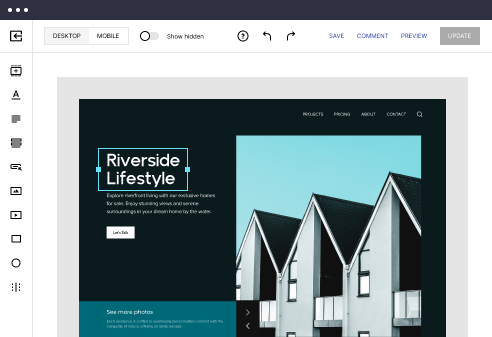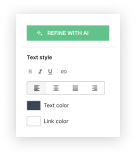
HTML page template for Java developers
Use TemplateAbout template
Attract clients and showcase your skills with style using our landing page templates for Java developers. Let's convert those visitors into clients!
Recommended templates
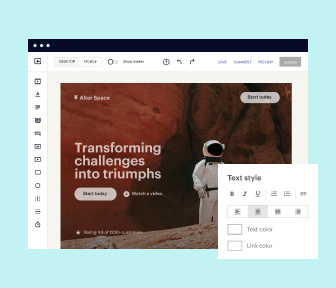
Easy to build without coding
With the intuitive drag-and-drop builder, anyone on your team can create high-converting pages without any knowledge of code or design. Make enhancements to your landing page with custom widgets using Javascript, HTML/CSS, or third-party scripts.
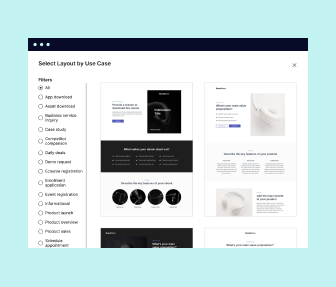
Multiple layouts for any industry and goal
Select from 500+ landing page layouts built to boost conversions across industry-specific scenarios. Customize them by adjusting fonts, adding images, and generating on-brand content with the AI assistant. Quickly scale with Instablocks® and Global Blocks that you can save, reuse, and update globally.
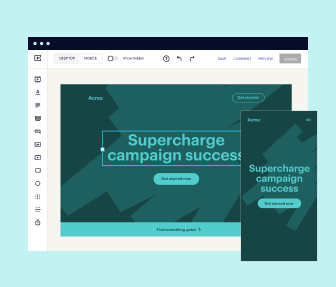
Loads fast and looks polished on any device
Every template is responsive, which means they present professionally on any device and load blazingly fast with our Thor Render Engine. You can also power them up with Google AMP technology to deliver an unparalleled mobile experience and drive higher conversions.
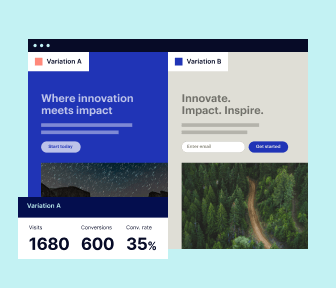
Robust analytics & experimentation
Get real-time updates and reporting across all your devices, showing the number of visitors, conversions, cost-per-visitor, and cost-per-lead. Launch AI-powered experiments, run A/B tests, and use heatmaps to analyze user behavior, then optimize your landing page to maximize conversions.

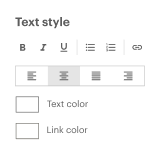
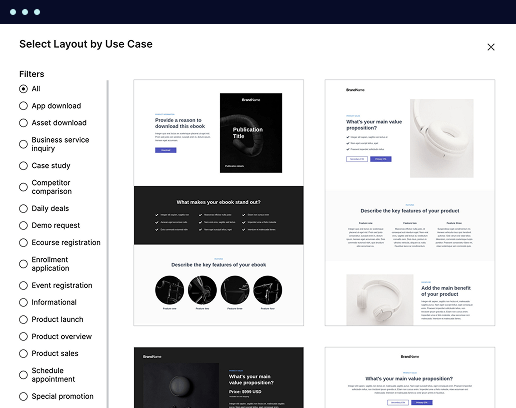
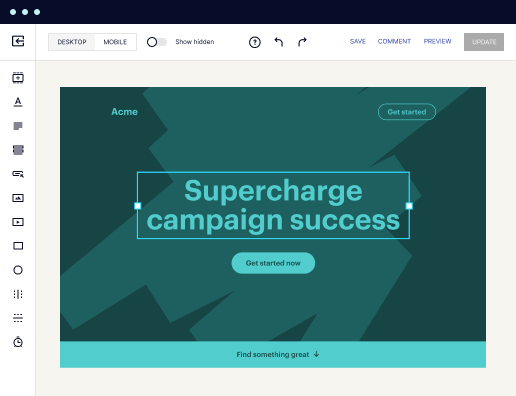

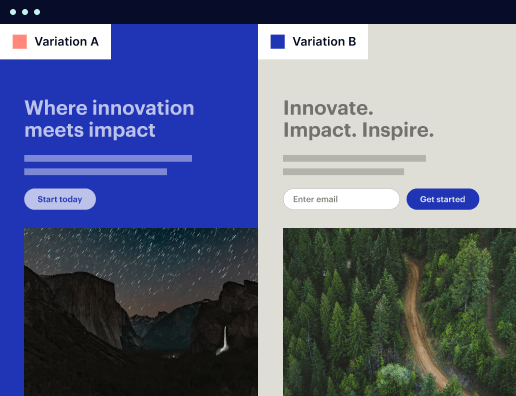

Easy to build without coding
With the intuitive drag-and-drop builder, anyone on your team can create high-converting pages without any knowledge of code or design. Make enhancements to your landing page with custom widgets using Javascript, HTML/CSS, or third-party scripts.
Multiple layouts for any industry and goal
Select from 500+ landing page layouts built to boost conversions across industry-specific scenarios. Customize them by adjusting fonts, adding images, and generating on-brand content with the AI assistant. Quickly scale with Instablocks® and Global Blocks that you can save, reuse, and update globally.
Loads fast and looks polished on any device
Every template is responsive, which means they present professionally on any device and load blazingly fast with our Thor Render Engine.
Robust analytics & experimentation
Get real-time updates and reporting across all your devices, showing the number of visitors, conversions, cost-per-visitor, and cost-per-lead. Launch AI-powered experiments, run A/B tests, and use heatmaps to analyze user behavior, then optimize your landing page to maximize conversions.
All the features you need to build java website template
Explore more featuresLearn how to build java website templates free download
Frequently asked questions about free download template for website in jsp
Leading the way in building high-performing landing pages





Java html template: Your ultimate how-to guide
Would you ever think that creating a professional and high-converting web page is easy? With Instapage, you have everything you need to for that to happen, even if you need more experience! Our robust end-to-end platform empowers you to create fast, efficient, and high-converting landing pages. Pick our professionally designed and editable HTML page template for Java developers to boost your digital presence and streamline your marketing efforts. Look at the aspects that make it a go-to solution for your company.
The game-changing grounds to use our HTML page template for Java developers
The main advantages of Instapage templates are their ease of use and fast setup. There’s no need for coding. With ready-made goal-specific designs and a intuitive drag-and-drop interface, you can quickly get what you need. Customize your HTML page template for Java developers in the editing mode, place new page sections and visual elements, or alter backgrounds and fonts to correspond with your brand. The AI content generator helps you compose compelling texts that resonate and convert.
But Instapage is not only about web page creation. It’s also your key to increasing the performance of your online marketing projects. A/B testing, SEO optimization, team collaboration, analytics, and integrations - you gain a comprehensive toolkit to fine-tune your landing pages for optimal outcomes.
Why wait? Select from our templates to develop optimized pages aligned with your brand's vision. Reach higher conversions and drive your business forward with Instapage today!
HTML page template for Java developers
The importance of HTML page templates for Java developers
In the evolving landscape of web development, HTML page templates serve as a foundational element for Java developers. These templates not only streamline the development process but also enhance the overall structure and functionality of web applications. By offering a standardized format, HTML templates facilitate efficient coding practices, allowing developers to focus on creating dynamic functionalities without getting bogged down in repetitive HTML markup. As Java continues to be a central language for server-side development, understanding how to effectively integrate HTML templates is essential for delivering high-quality applications.
The role of HTML in Java development
HTML plays a critical role in Java development as it provides the structure needed for web content. Java developers rely heavily on HTML to define the frontend of their applications, creating a bridge between user interaction and backend functionality. The synergy between HTML and Java is particularly evident in Java-based frameworks such as JSP and JSF, where HTML markup is dynamically generated on the server side. Properly structured HTML not only aids in content delivery but also enhances user experience, ensuring that applications are accessible and engaging.
Utilizing semantic HTML plays a crucial role in this process as well. Semantic elements improve accessibility by providing meaningful context to assistive technologies, and they support search engine optimization (SEO) efforts. For Java developers, adhering to semantic practices helps ensure their applications are user-friendly and discoverable, which can ultimately lead to higher engagement and retention rates.
Key components of an HTML page template
An effective HTML page template consists of essential components that lay the groundwork for any web application. At its core, an HTML page is defined by foundational tags like ``, ``, and ``. The `` tag signifies the start of an HTML document, while the `` section contains meta-information about the page, such as the title and links to stylesheets. The `` tag encompasses all the content that users interact with, which highlights its importance.
Meta tags: These tags provide critical information such as character set and viewport settings, which are essential for responsive design.
CSS and JavaScript links: Properly linking CSS stylesheets and JavaScript files ensures that web applications are visually appealing and functional.
JavaScript libraries: Integrating frameworks like jQuery or Bootstrap within the HTML template can significantly enhance user experience and interactive elements.
Benefits of using HTML templates for Java applications
HTML templates offer numerous advantages for Java developers, primarily by streamlining the development process. The use of predefined structures allows developers to save time by eliminating repetitive tasks associated with creating individual HTML files. Instead, they can focus their efforts on building out the dynamic aspects of an application, such as database interactions and business logic. This not only speeds up development timelines but also accelerates deployment cycles, which is crucial in today’s fast-paced tech world.
Consistency in design is another significant benefit. By utilizing a shared HTML template across projects, developers ensure that their applications follow a uniform structure and styling, which contributes to easier maintainability. Additionally, when team members use the same templates, collaboration becomes smoother as they can easily understand and modify each other's code. Lastly, the practice of employing reusable code snippets encapsulated within templates promotes better organization and modularity, which makes debugging and updates substantially easier.
Innovations in HTML template design
As web technologies evolve, so too do the techniques for designing HTML templates. Responsive design frameworks like Bootstrap have transformed how developers create user-friendly interfaces that adapt seamlessly across different devices. Utilizing a grid system within these frameworks facilitates a fluid layout, ensuring optimal presentation on both mobile and desktop platforms. This innovation in design not only enhances user experience but also increases developer efficiency by providing ready-to-use components.
Moreover, HTML5 has introduced several features that significantly improve the interactivity of web applications. Elements such as ``, ``, and new APIs enable rich media experiences and client-side processing without the need for extensive JavaScript. This integration simplifies the development process while enabling developers to create engaging applications that capture user interest. However, it’s essential to remain aware of accessibility considerations, ensuring that all users have equitable access to content and features, which can be achieved by adhering to HTML best practices and guidelines.
Popular Java technologies that optimize HTML template usage
Several Java technologies enhance the effectiveness of HTML templates in web applications. JavaServer Pages (JSP) stands out as a technology that allows developers to embed Java code directly within HTML, creating dynamic content that can be served to users. This integration ensures that developers can leverage Java's robust capabilities in servicing requests without compromising on HTML’s structural integrity. Conversely, Servlets provide an alternative approach for generating HTML dynamically, allowing for more control over the request-response cycle.
JavaServer Faces (JSF) offers another unique method by integrating templating mechanisms that promote reusable UI components. This feature enables developers to create templates that can be easily utilized across various pages or components, supporting rapid development and maintaining consistent design standards. Furthermore, the Spring Framework and Thymeleaf are key players in this arena, enabling seamless dynamic HTML generation that integrates well with Spring's backend functionalities. This broad spectrum of technologies underscores the critical role HTML templates play in maximizing the capabilities of Java-based web applications.
Tailoring HTML page templates to meet community needs
Listening to the developer community is essential for the continuous improvement of HTML page templates. Engaging with developer collectives and forums allows Java developers to gather feedback about existing templates and identify potential areas for enhancement. Understanding user requirements from this perspective not only promotes innovation but also helps in building templates that resonate with the target audience. Consequently, this approach ensures that templates remain relevant and effectively meet the real-world demands of developers.
Popular open-source templates often serve as valuable assets for Java projects, providing ready-made solutions that speed up development. These templates can be customized to meet specific needs while drawing on community contributions to ensure a diverse range of features and designs. By leveraging the insights and creativity of a broad community, developers can enhance their projects substantially, resulting in well-rounded, user-friendly applications.
Best practices for creating effective HTML page templates
Creating effective HTML page templates involves several best practices that promote scalability and maintainability. A modular design is essential, which encourages breaking down templates into smaller, reusable components or sections. By employing this approach, developers can easily modify or update individual sections without impacting the entire structure. This practice leads to reduced redundancies in code and facilitates easier updates as technology evolves.
Documenting and commenting within HTML files is another invaluable practice. By adequately commenting on their code and providing explanations for complex sections, developers bolster team accessibility and ensure that new team members can quickly understand existing templates. Furthermore, utilizing version control systems to maintain records of template iterations ensures that developers can track changes and revert to previous versions if necessary. This systematic approach fosters collaboration, as multiple developers can work on the same template without fear of overwriting previous contributions.
Exemplary use cases for HTML templates in Java development
HTML templates find a variety of applications across Java development, particularly in projects like e-commerce platforms. In these scenarios, templates can be tailored to provide visually appealing product pages that enhance user experience, encouraging higher conversion rates. Developers can create standardized templates for product listings, checkout processes, and user reviews, which streamline the development process and maintain a cohesive design across the site.
Content management systems also benefit significantly from HTML templates by enabling dynamic data rendering. Developers can create templates that pull in content from databases, ensuring that updates can be made easily without altering the underlying HTML structure. Similarly, enterprise applications often require customized templates tailored to specific team or departmental needs, showcasing the flexibility and adaptability that HTML templates offer across various sectors.
Mapping out the future of HTML templates in Java
The future of HTML templates in Java development appears promising as technology continues to evolve. The landscape of web development is shifting towards even more seamless integration of frontend and backend technologies, which paves the way for template-driven frameworks to flourish. Predictions indicate a continued ascent in server-side rendering and static site generation techniques, allowing developers to efficiently deliver dynamic content while optimizing performance.
As collaboration tools develop further, distributed teams will find it easier to work on templates collectively. Innovations in version control and project management will allow multiple developers to contribute to templates simultaneously without the risk of conflicts. This evolution in collaborative practices will ultimately contribute to faster development cycles, driving forward the pace of innovation in HTML template design and usage.
Key questions to consider when choosing an HTML template
Selecting the right HTML template for a Java project requires critical evaluation of several factors. It’s essential to ask what features the template offers that will add value specifically to your application. Developers should consider how the template aligns with current technology standards, such as responsiveness and cross-browser compatibility, to ensure a positive user experience.
Community support: Check if there is a robust support system available for the template in case of troubleshooting needs.
Ease of customization: Ensure the template is flexible enough to adapt to your project’s unique requirements.
Performance metrics: Assess if the template is optimized for performance, which directly affects user engagement.
Importing and accessing templates in your Java project
Integrating HTML templates into Java environments can be a straightforward process with the right approach. Begin by ensuring that the template files are correctly organized within your project structure, observing proper directory hierarchies to facilitate easy access. Developers can utilize built tools and frameworks to manage template imports effectively, allowing them to load HTML dynamically and maintain project workflow.
Managing external dependencies is also crucial. When incorporating libraries such as Thymeleaf or JSTL, ensuring they are up to date and properly referenced in your project is essential for maintaining functionality. Clean code practices should guide the organization of template logic and external scripts, resulting in coherent templates that integrate seamlessly into Java applications. This careful management contributes to a more efficient development process and enhances the overall maintainability of your code.
A deeper look into community contributions and open-source templates
Community contributions and open-source HTML templates have become invaluable resources for Java developers. Popular repositories such as GitHub and Bitbucket house a wealth of templates suited for a variety of projects, allowing developers to benefit from shared knowledge. Participating in these communities not only permits developers to access innovative templates but also provides opportunities for contributing new features or improvements. By participating in this collaborative environment, developers can further enrich their own projects while supporting the wider Java development community.
Furthermore, utilizing diverse community-driven resources helps Java developers stay up-to-date with industry trends and best practices. By referencing and incorporating these templates, developers can implement features that are established and tested across various projects, reducing the likelihood of errors in their applications. The variety of template objects tailored for specific needs ensures that developers can find a solution that works for them, fostering a culture of collaboration and shared success.
Final thoughts
The transformative impact of HTML templates on Java development cannot be understated. They serve as a vital aspect of web application design, offering Java developers an efficient means to structure their content while focusing on dynamic functionality. As the landscape of web technology continues to evolve, the importance of engaging with the community and adopting best practices remains paramount. By continually exploring new templating techniques and frameworks, developers can ensure that they are equipped to meet modern development challenges and deliver high-quality applications that resonate with users.
Encouraging experimentation and creative solutions in templating can drive innovation within the Java community. By harnessing the power of HTML templates, Java developers will not only enhance their workflow but also contribute to a rich ecosystem of shared knowledge and resources.
Ready to skyrocket conversions?
Supercharge your ad campaigns with high-performing landing pages
Get started